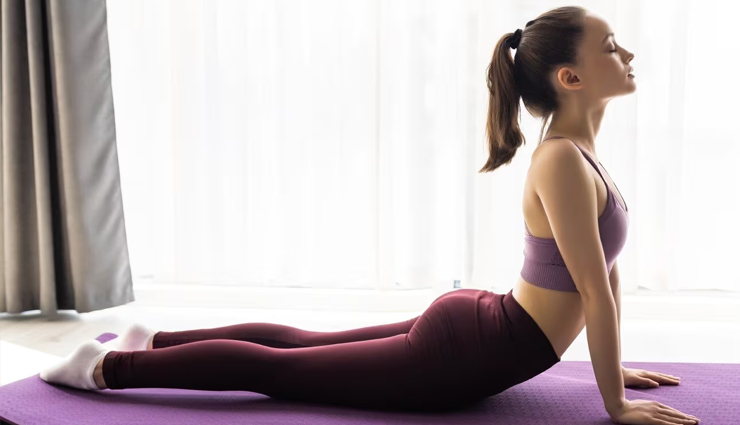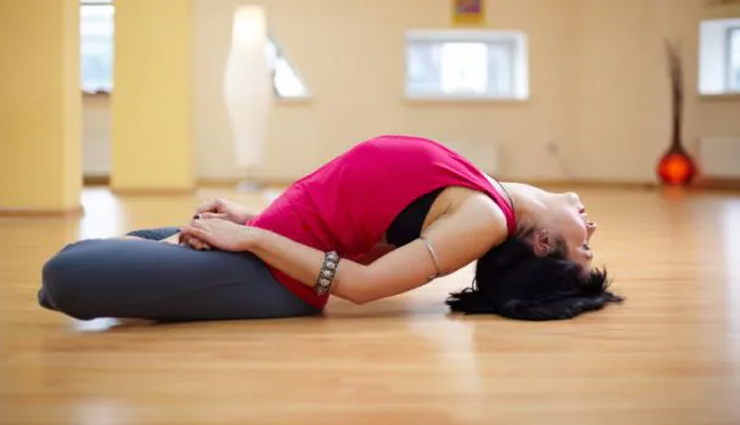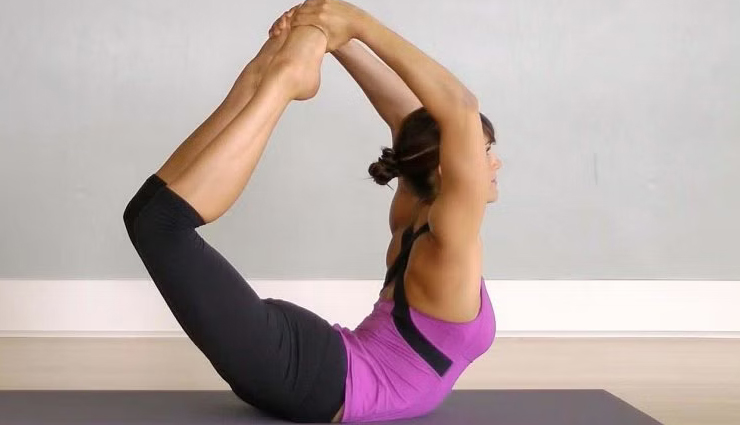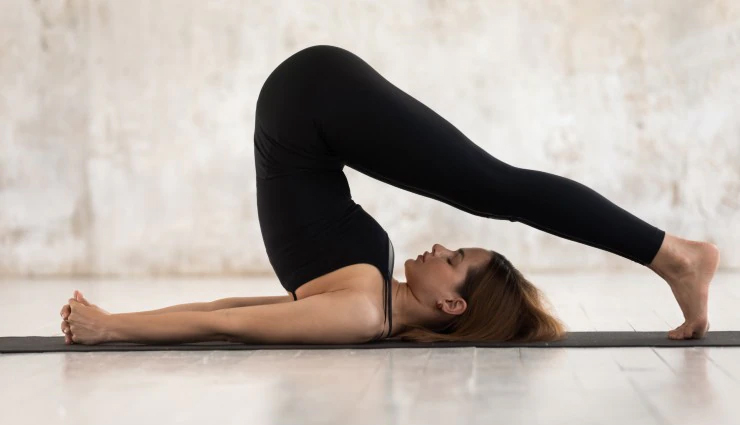- Home›
- Healthy Living›
- International Yoga Day 2023- 4 Yoga Asanas To Help You Get Relief From Frozen Shoulder
International Yoga Day 2023- 4 Yoga Asanas To Help You Get Relief From Frozen Shoulder
By: Pinki Tue, 20 June 2023 1:13:58

Frozen shoulder, also known as adhesive capsulitis, is a condition characterized by stiffness, pain, and limited range of motion in the shoulder joint. It typically develops gradually over time and can significantly impact a person's ability to perform daily activities and engage in physical tasks.
The shoulder joint is a ball-and-socket joint that allows for a wide range of motion. It is surrounded by a capsule of connective tissue, which provides stability and supports the joint's movement. In the case of frozen shoulder, this capsule becomes thickened, inflamed, and tight, leading to the characteristic symptoms.
The exact cause of frozen shoulder is not fully understood. However, certain factors may increase the risk of developing the condition. These include age (people between 40 and 60 years old are more commonly affected), gender (women are more prone to frozen shoulder), certain medical conditions such as diabetes or thyroid disorders, and previous shoulder injuries or surgeries.
The typical progression of frozen shoulder can be divided into three stages: freezing, frozen, and thawing. During the freezing stage, individuals experience increasing shoulder pain and a gradual loss of range of motion. The frozen stage is characterized by persistent pain and significant restriction of shoulder movement. Finally, the thawing stage involves a gradual improvement in range of motion and reduction in pain.
Diagnosing frozen shoulder involves a thorough physical examination, medical history review, and imaging tests such as X-rays or MRI scans. Treatment options for frozen shoulder aim to reduce pain, improve range of motion, and restore shoulder function. They often include a combination of pain management techniques, physical therapy, stretching exercises, and, in some cases, medications or corticosteroid injections. Surgery may be considered in rare cases when conservative treatments fail to provide relief.
Recovery from frozen shoulder can be a lengthy process, lasting several months to years, and the condition may recur. However, with proper treatment and rehabilitation, most individuals can regain a significant amount of shoulder function and reduce pain over time.
It is essential for individuals experiencing symptoms of frozen shoulder to consult with a healthcare professional for an accurate diagnosis and to develop an appropriate treatment plan tailored to their specific needs.

# Bhujangasana
Bhujangasana, also known as Cobra Pose, is a yoga asana that stretches and strengthens the muscles of the back, shoulders, and abdomen. Here's a step-by-step guide on how to perform Bhujangasana:
- Start by lying flat on your stomach on a yoga mat or comfortable surface. Place your forehead on the mat and keep your legs together, with the tops of your feet resting on the floor.
- Position your hands on the mat, just slightly in front of your shoulders, with your fingers pointing forward. Keep your elbows close to your body.
- Engage your leg muscles and press the tops of your feet firmly into the mat. Activate your pelvic floor muscles and gently tuck your tailbone towards the pubic bone to stabilize your lower back.
- Inhale deeply and slowly begin to lift your head, chest, and shoulders off the mat. Use the strength of your back muscles, rather than relying solely on your arms, to lift your upper body.
- Keep your gaze forward and avoid straining your neck. Lengthen the back of your neck by lifting the crown of your head towards the ceiling.
- As you continue to inhale, lift your body higher, straightening your arms while maintaining a slight bend in your elbows. Draw your shoulder blades back and down, creating a broadening sensation across your chest.
- Ensure that your lower body remains in contact with the mat, with your pelvis and thighs pressing into the floor. Avoid putting excessive pressure on your hands by using them primarily for support rather than relying on them to lift your upper body.
- Hold the pose for a few breaths, breathing deeply and evenly. Feel the stretch along the front of your body, particularly in your abdomen and chest.
- To release the pose, exhale and slowly lower your upper body back down to the mat, in a controlled manner.
- Rest in a relaxed position, such as Child's Pose, for a few breaths before repeating the Cobra Pose or moving on to other asanas.
As with any yoga pose, it's important to listen to your body and avoid pushing beyond your limits. If you have any pre-existing medical conditions or injuries, it's advisable to consult with a qualified yoga instructor or healthcare professional before attempting Bhujangasana or any other yoga practice.

# Matsyasana
Matsyasana, also known as Fish Pose, is a yoga asana that stretches the chest, neck, and shoulders while opening up the heart center. Here's a step-by-step guide on how to perform Matsyasana:
- Start by sitting on a yoga mat or comfortable surface with your legs extended in front of you. Place your hands alongside your hips, palms resting on the mat.
- Bend your knees and draw your feet closer to your pelvis. Slide your hands, palms down, underneath your buttocks, with your palms facing down and fingertips pointing towards your feet.
- Inhale deeply and press down firmly into your forearms and elbows. Use your lower arms for support as you begin to lift your chest and tilt your head back.
- As you lift your chest, gently lower the crown of your head towards the floor, creating a gentle arch in your upper back. Keep your neck long and relaxed, avoiding any strain.
- With your head and upper body lifted, press your thighs and legs down into the mat, engaging the muscles of your lower body.
- Hold the pose for a few breaths, breathing deeply and maintaining a steady and relaxed breath. Feel the stretch in your chest, throat, and front of the neck.
- To come out of the pose, gently lift your head and bring your chin back towards your chest. Release the arms from underneath your buttocks and extend your legs forward, returning to a seated position.
- Take a moment to rest and observe any sensations in your body before moving on to other asanas or ending your practice.
As with any yoga pose, it's important to listen to your body and modify or skip the pose if you have any neck or back injuries or discomfort. If you're new to Matsyasana or have any concerns, it's advisable to practice under the guidance of a qualified yoga instructor.

# Dhanurasana
Dhanurasana, also known as Bow Pose, is a yoga asana that stretches the entire front of the body while strengthening the back muscles. Here's a step-by-step guide on how to perform Dhanurasana:
- Start by lying flat on your stomach on a yoga mat or comfortable surface. Place your arms alongside your body, with your palms facing up.
- Bend your knees and bring your heels close to your buttocks, keeping them hip-width apart.
- Reach back with your hands and grasp your ankles or feet. If you cannot reach your feet, you can use a yoga strap looped around your ankles and hold onto the strap with your hands.
- Inhale deeply and, as you exhale, begin to lift your chest, head, and thighs off the mat. Simultaneously, pull your legs up and back, using the strength of your arms and legs.
- As you lift your body, maintain a gentle and controlled motion, avoiding any jerking or straining. Keep your knees hip-width apart and your toes pointing upwards.
- Find a balance between lifting your chest and thighs while also maintaining a lengthened and relaxed neck. Avoid straining your neck by keeping your gaze forward or slightly upward.
- Hold the pose for a few breaths, breathing deeply and evenly. Feel the stretch in the front of your body, particularly in your abdomen, chest, and thighs.
- To release the pose, gently exhale and lower your chest, head, and thighs back down to the mat. Release your hold on your ankles or feet and extend your legs, relaxing in a prone position.
- Rest in this position, observing any sensations in your body, before moving on to other asanas or concluding your practice.
As with any yoga pose, it's important to listen to your body and avoid pushing beyond your limits. If you have any pre-existing medical conditions or injuries, it's advisable to consult with a qualified yoga instructor or healthcare professional before attempting Dhanurasana or any other yoga practice.

# Halasana
Halasana, also known as Plow Pose, is a yoga asana that involves stretching and stimulating the back muscles, hamstrings, and shoulders. Here's a step-by-step guide on how to perform Halasana:
- Start by lying flat on your back on a yoga mat or comfortable surface. Extend your legs fully and place your arms alongside your body, with your palms facing down.
- Inhale deeply, then as you exhale, engage your core muscles and lift your legs off the ground, bringing them up and over your head. Use your abdominal strength to lift your hips off the floor.
- As your legs come over your head, support your lower back with your hands, placing them on your lower back for stability and to protect your spine. Keep your elbows shoulder-width apart and your fingers pointing upward.
- Continue to lift your legs until your toes touch the ground behind your head. If this is challenging, you can support your legs with your hands, placing them on your upper back or keeping them on your hips for additional support.
- Maintain the pose by keeping your legs straight and your toes flexed. Allow your breathing to remain calm and even, focusing on deep inhales and exhales.
- If you are comfortable and want to deepen the stretch, you can separate your hands from your lower back and place them on the mat, reaching them toward the floor behind you. This will increase the stretch in your shoulders and back.
- Hold the pose for several breaths, gradually working your way up to a minute or longer as you become more comfortable with the pose. Maintain awareness of your body and release the pose if you experience any discomfort or strain.
- To come out of the pose, bring your hands back to your lower back for support. Slowly and with control, roll your spine down onto the mat, one vertebra at a time, until your entire back is resting on the floor. Extend your legs and relax in a supine position.
- Take a few moments to rest and observe the effects of the pose on your body before moving on to other asanas or concluding your practice.
As with any yoga pose, it's important to listen to your body and avoid pushing beyond your limits. If you have any pre-existing medical conditions or injuries, it's advisable to consult with a qualified yoga instructor or healthcare professional before attempting Halasana or any other yoga practice.





